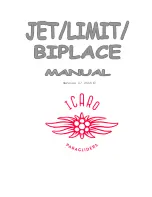
3.2 – Choosing which size to operate
YOU MUST ALWAYS USE THE RIGHT KITE SIZE FOR
THE GIVEN CONDITIONS.
The weight of the rider is a major factor in choosing the
surface area of the kite .
Wind direction
Make sure the wind direction is suited to the spot you have
chosen for sailing.
The ideal is cross-shore that is blowing parallel to the
beach.
NEVER launch your kite in an offshore or cross-offshore
wind.
Onshore wind can be good for the competent kitesurfer but
is dangerous because of objects down wind. Sail well off
shore.
3.3 – Turbulences
Obstacles situated upwind of
you can create turbulent air-
pockets, which often lead to
your kite stalling & depowering
abruptly, falling from the sky,
and suddenly powering up
dangerously.
Turbulence is present for a
down-wind distance equivalent
to approximately 7 times the
height of the obstacle.
Warning
: wind is always stronger at altitude than it is at ground level, be sure not to let this catch you unaware.
3.4 – The ‘wind-window’
This is a theoretical concept which you must have clear in your mind before using this kite. The wind-
window is the region of 3-dimensional space in which your kite will operate, and resembles one quarter of
a sphere.
IMPORTANT: The power generated by your kite will vary according to which part of the window it is flying
in.
Wind Window & Power Zones
Neutral zone
Power zone
Minimum power is at the ‘zenith’(directly above you),this is
called the neutral zone. Maximum power is generated when
the kite is located at the centre and towards the bottom of the
window, which is in effect dead downwind of you. Never fly
your kite in this power zone.
On the extreme right and left-hand edges of the window, the
power generated is moderate. These are the zones you will
mostly fly your kite in while sailing.
LAND
O
ffshor
e
wi
n
d
Cr
os
s-
off
win
d
Cross-shore wind
onshore
w
ind
Cr
os
s-o
n w
in
d
Land
on shor
e
w
in
d
sid
e-
on
sh
or
e
wi
nd
sid
e-
of
f s
ho
re
wi
nd
side shore wind
off shor
e
wind



































